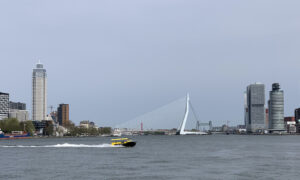Once they get over the shock of tax rates and the health care scheme, a lot of expats decide the quality of life (if not the climate) and business opportunities in the Netherlands are worth sending a big chunk of their income to the Tax Man every year. So, they start looking for a house.
Earlier this fall, the Financial Times reported more Dutch institutional investors such as insurance companies are turning to private funds to enter into the mortgage business.
Regiepartijens — funds that originate mortgage loans on behalf of institutional investors — now have a 10-percent market share, according to consultancy IG&H, up from a negligible share a few years ago. With key European Central Bank rates at zero or just below (i.e., they charge you to hold some deposits), institutional investors have to look harder for a return, and are willing to take on a little risk.
Regiepartijen is seen as a positive alternative to fee-heavy mortgage backed securities, which get tranched into fixed-return investments. Those MBSs are typically bought by the same institutional investors who now are looking at basically lending to home buyers directly.
What does all this mean for you? In macro economic terms, money is getting pumped into the housing market in the Netherlands, which means consumer interest rates for mortgages could drop. Interest rates for 10-year mortgages are under 4 percent at the moment.
To add to the excitement, the Dutch government is offering tax refunds on part of your mortgage interest in an effort to stimulate residential real estate. So, theoretically, buying a house could cost you less per month than paying rent, and of course paying rent doesn’t buy you any equity. ABN-Amro even has a section devoted to helping expats buy a home in the Netherlands.
Now, you ask, should I be buying a house in, say, Amsterdam?
Yes.
If you’re stinking rich.
The Wall Street Journal, that arbiter of global good taste, did a post last spring, “Amsterdam’s Low-Key Luxury Homes,” on that very subject.

In it, author Ruth Bloomfield found Dutch real estate prices collapsed during the Great Recession, then stayed depressed for about six years. As in the United States, the Dutch uber-rich are back with a vengeance, and luxury home prices are rising, in some cases returning to pre-recession highs. Plus foreign buyers are pumping up the Amsterdam market.
The average property price in the city is about 280,000 euros, or about $308,000 at today’s exchange rate, according to the WSJ. And trust me, an ordinary single-family home in the Netherlands is tiny by American standards, maybe 1,200 square feet if you’re lucky.
Ah, but you don’t want an ordinary house. You want a very cool house on a canal, right in the heart of Amsterdam, where the action is. That will set you back about $4 million to $8 million, depending on size and location. Less than on Central Park in Manhattan or the 2nd Arrondissement in Paris, but a heck of a lot more than you’re going to pay in, say, Riga.

Here’s an alternative. We spent much of the summer in Eindhoven, where housing prices are far more affordable than Amsterdam. Demand for homes is only slowly recovering in this provincial town that has a lot of talent and commerce, but is canal-free and has a low old-world-charm quotient.
But, as in choosing the Brooklyn over Manhattan, you get a heck of a lot more house for your euro. First thing you have to understand is, there are relatively few palatial homes in the Netherlands. A 3,000-square-foot house is considered extravagant for a single family.
Eindhoven homes in that range run you about 500,000 euros.
Of course, location is key, and in Europe as a whole, a new, sleek apartment in a trendy section of the center city – a very small, sleek apartment – will set you back on average 300,000 euros-plus. A large house outside a city center, or even in a neighboring village, will be more affordable, because most people prefer to live near public transportation and shopping.
 Interestingly, the arbitrage between buying and renting is a bit skewed. In vibrant U.S. cities such as Dallas, rental rates have risen dramatically in the past two years because demand for Class-A multi-family exceeds supply as Millennials have been slow to embrace home ownership.
Interestingly, the arbitrage between buying and renting is a bit skewed. In vibrant U.S. cities such as Dallas, rental rates have risen dramatically in the past two years because demand for Class-A multi-family exceeds supply as Millennials have been slow to embrace home ownership.
But in Eindhoven, renting is cheaper, because we were told homes don’t sell quickly, and owners want to have some income during the months it might sit on the market. Also, Eindhoven hosts a large community of corporate expats, and there seem to be executive-quality houses that rotate in and out of corporate leases.

Check out this 560 m2 (6,030 square foot) luxury rental, which is going for 2,950 euros per month, a huge bargain compared to Amsterdam, where a similar house would be at least 5,000 euros per month.
My point in all this – and I do have one – is, trends in the Netherlands and in other nations in Europe are increasingly favorable for expats, from the new startup visas in the Netherlands, France and Spain, to cheap (for the moment) housing that’s a residual benefit from the last time the global bubble burst.
But you get out of it what you put into it, so get ready to look, learn and spend a lot of time crunching the numbers.
Co-CEO of Dispatches Europe. A former military reporter, I'm a serial expat who has lived in France, Turkey, Germany and the Netherlands.















